Rapid-Fire Fingerprinting
| Power Pitch Session: How it Works | |
|
1st Hour: 2-minute Power Pitches inside the Power Pitch Theater. 2nd Hour: 60-minute Digital Poster Presentations at the numbered plasma screens outside the Power Pitch Theater. |
1st Hour
Pitch: Rapid - Fire FingerprintingPower Pitch
Acquisition, Reconstruction & Analysis
Wednesday, 15 May 2019
Power Pitch Theater C - Exhibition Hall
13:30 - 14:30
Moderators: Yun Jiang, Ricardo Otazo
2nd Hour
Poster: Rapid Fire MR FingerprintingPower Pitch Poster
Acquisition, Reconstruction & Analysis
Wednesday, 15 May 2019
Power Pitch Theater C - Exhibition Hall
14:30 - 15:30
| Plasma # | |||
 |
0806. 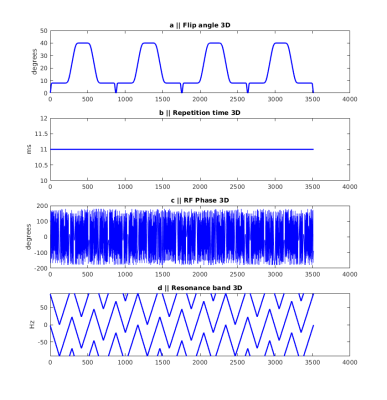 |
31 | 3D Magnetic Resonance Fingerprinting with Quadratic RF Phase
Rasim Boyacioglu, Charlie Wang, Dan Ma, Debra McGivney, Xin Yu, Mark Griswold
Magnetic Resonance Fingerprinting with quadratic RF phase (qRF-MRF) has previously been reported for simultaneous quantitative mapping of T1, T2 and T2* relaxation times and off resonance for 2D acquisitions. Translation of qRF-MRF to 3D bears practical limitations for reconstruction and dictionary matching due to increase in data and dictionary sizes. Here, randomized SVD based time compression and reduction in dictionary size with quadratic fit are combined to overcome prohibitively large datasets and long reconstruction times of 3D qRF-MRF. Whole brain 3D qRF-MRF can be acquired in 5 minutes and is compared to 2D qRF-MRF and 3D FISP.
|
0807. 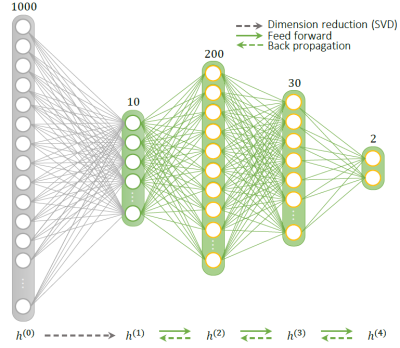 |
32 | Deep MR Fingerprinting with total-variation and low-rank subspace priors
Mohammad Golbabaee, Carolin Pirkl, Marion Menzel, Guido Buonincontri, Pedro Gómez
Deep learning (DL) has recently emerged to address the heavy storage and computation requirements of the baseline dictionary-matching (DM) for Magnetic Resonance Fingerprinting (MRF) reconstruction. Fed with non-iterated back-projected images, the network is unable to fully resolve spatially-correlated corruptions caused from the undersampling artefacts. We propose an accelerated iterative reconstruction to minimize these artefacts before feeding into the network. This is done through a convex regularization that jointly promotes spatio-temporal regularities of the MRF time-series. Except for training, the rest of the parameter estimation pipeline is dictionary-free. We validate the proposed approach on synthetic and in-vivo datasets.
|
|
0808. 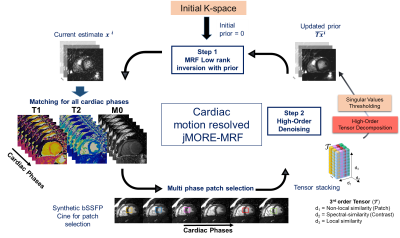 |
33 | Cardiac motion resolved Magnetic Resonance Fingerprinting with joint reconstruction: jMORE-MRF
Olivier Jaubert, Gastao Cruz, Aurelien Bustin, Torben Schneider, Peter Koken, Mariya Doneva, Rene M. Botnar, Claudia Prieto
ECG-triggered cardiac Magnetic Resonance Fingerprinting (cMRF) has been proposed to provide simultaneous myocardial T1 and T2 mapping from a single scan. A “free-running” motion-resolved cardiac MRF (MORE-MRF) approach has been recently introduced to provide T1 and T2 myocardial characterization over the entire cardiac cycle. Here we propose to improve MORE-MRF by exploiting redundancy between the different cardiac phases within a novel motion resolved multi-contrast reconstruction framework. The feasibility of this joint MORE-MRF approach (jMORE-MRF) was evaluated in phantom and healthy subjects and compared against conventional T1 and T2 mapping techniques.
|
|
 |
0809. 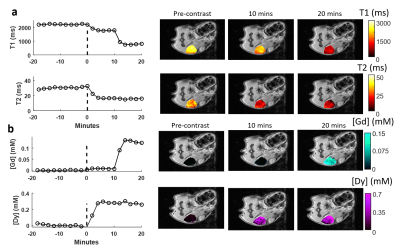 |
34 | In Vivo Multi-Color Magnetic Resonance Fingerprinting
Christian Anderson, Mette Johansen, Bernadette Erokwu, He Hu, Yuning Gu, Mark Griswold, Nicole Steinmetz, Susann Brady-Kalnay, Xin Yu, Chris Flask
Contrast enhanced MRI studies are currently limited to observing a single contrast agent at a time. Meanwhile, optical imaging methods frequently utilize multiple fluorophores in “multi-color” imaging studies to track multiple molecular events simultaneously. We propose the novel DC-MRF method as a way to realize an analagous “multi-color” MRI. Herein, we demonstrate the first in vivo application of multi-color MRF and validate its ability to accurately and dynamically map the concentration of multiple contrast agents in vivo. This method creates the opportunity to perform a wide range of novel multi-agent MRI studies that immediately broadens the scope of contrast enhanced MRI.
|
 |
0810. 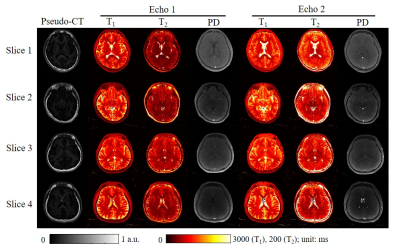 |
35 | Simultaneous Pseudo-CT and Parametric Mapping of Human Brain Using Dual Echo Ultrashort Echo Time MR Fingerprinting (deUTE-MRF)
Qing Li, Huihui Ye, Xiaozhi Cao, Yingying Li, Hongjian He, Jianhui Zhong
A dual echo ultrashort echo time MR fingerprinting (deUTE-MRF) sequence is proposed to simultaneously generate
|
0811. 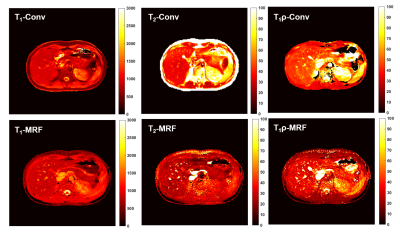 |
36 | T1, T2, and T1? Magnetic Resonance Fingerprinting of the Abdomen
Cory Wyatt, Thomas Barbara, Alexander Guimaraes
T1p relaxation mapping is an intensive technique in terms of acquisition time and specific absorption rate (SAR), making it difficult to acquire in the abdomen. In this study, magnetic resonance fingerprinting (MRF) techniques are applied to simultaneously acquire T1, T2, and T1p relaxation times by adding spin lock pulses before periods of flip angle and TR modulation. MRF and conventional sequences were acquired in phantoms and the abdomen of healthy volunteers. Good agreement was found between the T1, T2, and T1p values from MRF and conventional sequences.
|
|
0812. 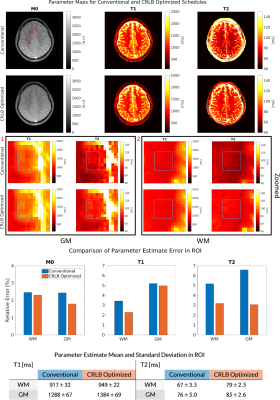 |
37 | Flexible and Efficient Cramér-Rao Bound Optimization for Magnetic Resonance Fingerprinting using Automatic Differentiation of Bloch Simulations
Philip Lee, Lauren Watkins, Timothy Anderson, Guido Buonincontri, Brian Hargreaves
The Cramér-Rao Lower Bound (CRLB) is a metric for optimizing quantitative sequences that requires an analytical expression for the signal. The CRLB for Magnetic Resonance Fingerprinting (MRF) has a complex formulation that makes it difficult to account for system imperfections or relevant signal contributions such as diffusion. We apply automatic differentiation to Bloch simulations and choose flip angles and repetition times that optimize the CRLB of the MRF sequence without deriving an explicit analytical expression for the signal. This method is computationally efficient and can easily be extended to include B0 and B1 inhomogeneities. Results are validated with in-vivo measurements.
|
|
0813. 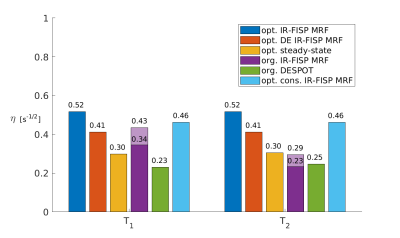 |
38 | Parameter Encoding Efficiency in Transient and Steady-State Quantitative MRI Methods
David Leitão, Joseph V. Hajnal, Rui Teixeira, Shaihan Malik
This work proposes a neutral measure of encoding efficiency per square-root of time excluding any effects of image reconstruction from the analysis in order to compare spoiled gradient-echo based Magnetic Resonance Fingerprinting and steady-state methods for and estimation.
The results obtained indicate that gradient spoiled Fingerprinting is up to more
efficient per square-root-time than steady-state methods. The optimal sequences of pulses found have striking features with different duration fingerprint strategies having highest efficiency under different boundary conditions.
|
|
0814. 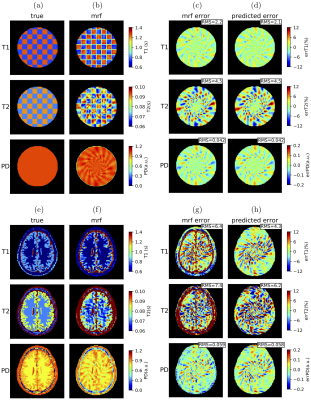 |
39 | Understanding the combined effect of k-space undersampling and transient states excitation in MR Fingerprinting reconstructions: the role of incoherence
Christiaan Stolk, Alessandro Sbrizzi
The main characteristic of an MRF sequence is the simultaneous application of (a) transient states excitation and (b) highly undersampled k-space. Despite the promising empirical results obtained with MRF, no work has appeared that formally describes the combined impact of these two aspects on the reconstruction accuracy. We derive a mathematical model that directly relates the time varying RF excitation and the k-space sampling to the spatially dependent reconstruction errors. An in-depth analysis of the model reveals that, analogously to the compressed sensing framework, incoherence plays a fundamental role also in MRF.
|
|
0815. 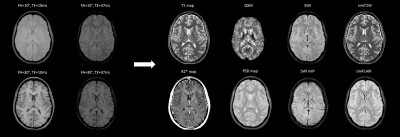 |
40 | Rapid protocol for T1 and T2* mapping: STrategically Acquired Gradient Echo (STAGE) at 1.5 T MRI
Maria Marcella Laganà, Yongsheng Chen, Laura Pelizzari, Pietro Cecconi, Francesca Baglio, Mark Haacke
Multi-contrast quantitative mapping has become an important research direction for characterizing brain tissue in physiological and pathological conditions. A rapid quantitative mapping acquisition is fundamental for its application in clinical routine. In this study, we adapted the STrategically Acquired Gradient Echo (STAGE) protocol for a clinical 1.5T MRI scanner. Using STAGE, we reconstructed longitudinal and effective transverse relaxation time maps. We obtained values similar to those in the literature in different brain structures with high repeatability. These results suggest that STAGE can be used at 1.5T and provide a variety of quantitative maps with an acquisition time of 7 minutes.
|
|
0816. 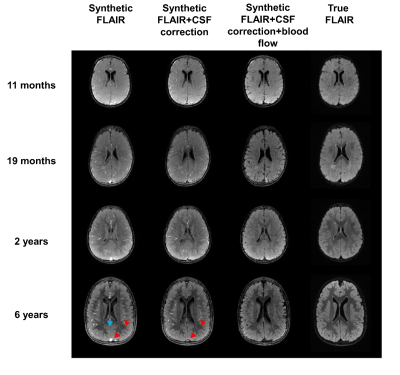 |
41 | Chasing True FLAIR: a three-component Magnetic Resonance Fingerprinting approach to synthetic MRI
Matteo Cencini, Guido Buonincontri, Laura Biagi, Pedro Gómez, Rolf Schulte, Michela Tosetti
MR Fingerprinting is a multiparametric imaging technique which allows to obtain several parametric maps of tissue, such as Proton Density and T1/T2 maps, within a single fast acquisition in transient-state. These maps can be used to synthesize a whole set of different contrast-weighted images, potentially substituting an entire conventional protocol. However, these synthetic images suffer from artifacts due to partial volume effects. This is particularly true for FLuid Attenuated Inversion Recovery (FLAIR) images. Here, we modify the signal model to account for CSF and flowing blood, correcting these artifacts, and we compared the resulting synthetic FLAIR to true FLAIR images.
|
|
0817. 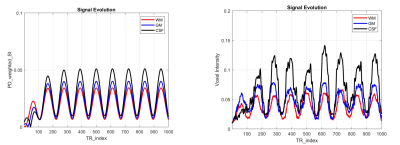 |
42 | Rapid open source prototyping of Magnetic Resonance Fingerprinting using Pulseq to enable multi-site two vendor studies
Enlin Qian, Sairam Geethanath, Jon-Fredrik Nielsen, John Vaughan Jr
This work develops an open source package that allows for rapid prototyping of magnetic resonance fingerprinting (MRF) using Pulseq. In this work, an inversion recovery steady state free precession (IR-SSFP) sequence is designed in Pulseq. TR, flip angles, and TE are selected to achieve variations of contrast. The sequence was implemented, simulated, and applied on five health volunteer brain scans. The scan time of one subject for single slice sequence was 35 seconds. The data was sliding window reconstructed and matched with the simulated dictionary. The dictionary matching shows similar T1 and T2 results as reported in literature.
|
|
0818 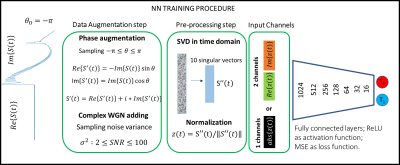 |
43 | Deep Learning for Magnetic Resonance Fingerprinting: Data Augmentation with Phase Encoding and SVD Preprocessing for Accurate Parameter Reconstruction of FISP Data. Video Permission Withheld
Marco Barbieri, Philip Lee, Leonardo Brizi, Enrico Giampieri, Alexander Toews, Gastone Castellani, Daniel Remondini, Brian Hargreaves, Claudia Testa
Dictionary size limits the number of parameters one can aim to estimate with Magnetic Resonance Fingerprinting (MRF) Deep Neural networks (NN) have been recently proposed for MRF applications, both with numerical simulationsand with phantoms and in-vivo acquisitions. With real-valued NNs only the magnitude of the MRF signal has been considered as input. This choice releases from the need of considering the phase of the signal during training but can affect noise robustness and signal differentiation due to loss of information. In this work we propose a strategy to train a real valued NN that takes the real and imaginary parts of an MRF-FISP signal as input. We also propose to use SVD as preprocessing step for noise reduction. The presented results may help the developing of deep learning approaches for MRF, pushing fingerprinting pulse sequences design to add more meaningful MR parameters, such as diffusion, with no more limitations due to the dictionary size.
|
|
0819. 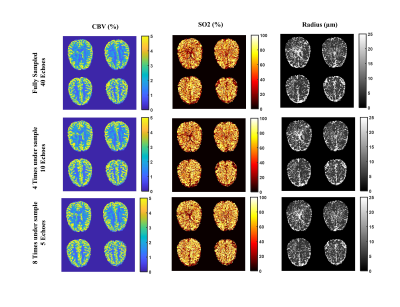 |
44 | Exploring the Accuracy of MR Vascular Fingerprinting: Potential Pitfall and Possible Remedy
Mahdi Khajehim, Thomas Christen, Greg Zaharchuk, J. Jean Chen
MR vascular fingerprinting (
|
|
0820. 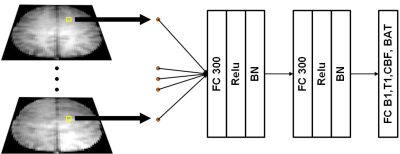 |
45 | Deep learning based MR fingerprinting ASL ReconStruction (DeepMARS)
Qiang Zhang, Pan Su, Ying Liao, Rui Guo, Haikun Qi, Zhangxuan Hu, Hanzhang Lu, Huijun Chen
The purpose of this study is to develop a MRF-ASL reconstruction algorithm using deep learning (DeepMARS). Compared with the traditional dictionary matching, our DeepMARS achieved higher intra-class correlation (ICC) in B1 (0.971 vs 0.921) and BAT (0.926 vs 0.761), similar ICC in T1 (0.957 vs 0.964) and CBF (0.936 vs 0.948) in the reproducibility test with much shorter calculation time per voxel (0.368 ms vs 2.899 s), suggesting that our DeepMARS may be a better alternative than the conventional MR dictionary matching approach.
|
 Back to Program-at-a-Glance |
Back to Program-at-a-Glance |  Back to Top
Back to Top